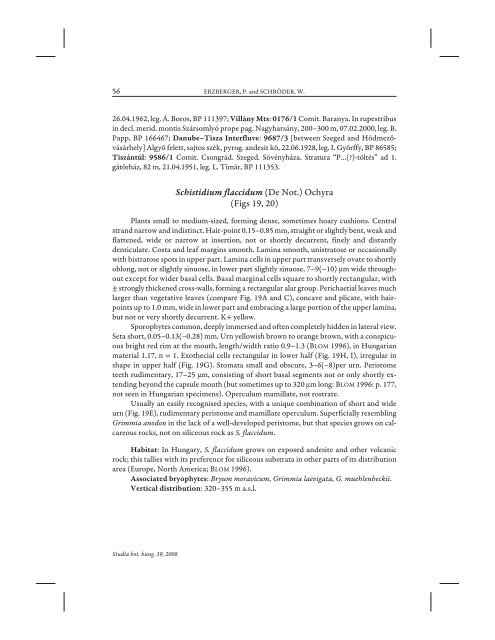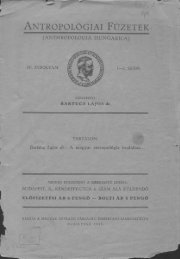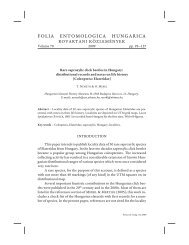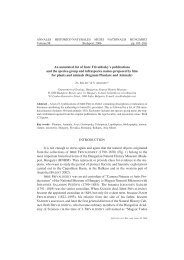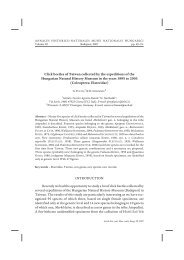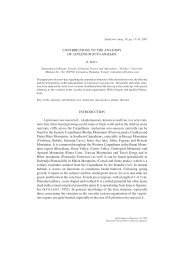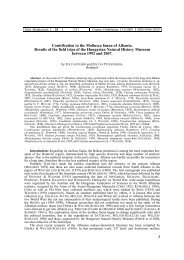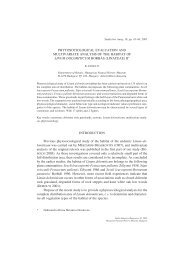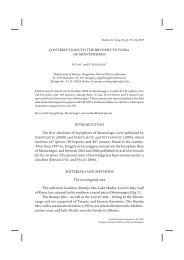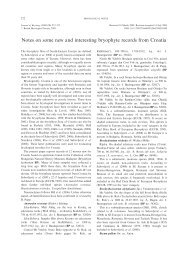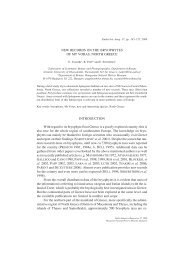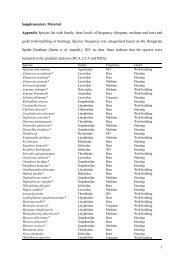THE GENUS SCHISTIDIUM (GRIMMIACEAE, MUSCI) IN HUNGARY ...
THE GENUS SCHISTIDIUM (GRIMMIACEAE, MUSCI) IN HUNGARY ...
THE GENUS SCHISTIDIUM (GRIMMIACEAE, MUSCI) IN HUNGARY ...
You also want an ePaper? Increase the reach of your titles
YUMPU automatically turns print PDFs into web optimized ePapers that Google loves.
56 ERZBERGER, P. and SCHRÖDER, W.<br />
26.04.1962, leg. Á. Boros, BP 111397; : Comit. Baranya. In rupestribus<br />
in decl. merid. montis Szársomlyó prope pag. Nagyharsány, 200–300 m, 07.02.2000, leg. B.<br />
Papp, BP 166467; : [between Szeged and Hódmezõvásárhely]<br />
Algyõ felett, sajtos szék, pyrog. andesit kõ, 22.06.1928, leg. I. Gyõrffy, BP 86585;<br />
: Comit. Csongrád. Szeged. Sövényháza. Stratura “P…(?)-töltés” ad 1.<br />
gátõrház, 82 m, 21.04.1951, leg. L. Timár, BP 111353.<br />
(De Not.) Ochyra<br />
(Figs 19, 20)<br />
Plants small to medium-sized, forming dense, sometimes hoary cushions. Central<br />
strand narrow and indistinct. Hair-point 0.15–0.85 mm, straight or slightly bent, weak and<br />
flattened, wide or narrow at insertion, not or shortly decurrent, finely and distantly<br />
denticulate. Costa and leaf margins smooth. Lamina smooth, unistratose or occasionally<br />
with bistratose spots in upper part. Lamina cells in upper part transversely ovate to shortly<br />
oblong, not or slightly sinuose, in lower part slightly sinuose, 7–9(–10) μm wide throughout<br />
except for wider basal cells. Basal marginal cells square to shortly rectangular, with<br />
± strongly thickened cross-walls, forming a rectangular alar group. Perichaetial leaves much<br />
larger than vegetative leaves (compare Fig. 19A and C), concave and plicate, with hairpoints<br />
up to 1.0 mm, wide in lower part and embracing a large portion of the upper lamina,<br />
but not or very shortly decurrent. K+ yellow.<br />
Sporophytes common, deeply immersed and often completely hidden in lateral view.<br />
Seta short, 0.05–0.13(–0.28) mm. Urn yellowish brown to orange brown, with a conspicuous<br />
bright red rim at the mouth, length/width ratio 0.9–1.3 (BLOM 1996), in Hungarian<br />
material 1.17, n = 1. Exothecial cells rectangular in lower half (Fig. 19H, I), irregular in<br />
shape in upper half (Fig. 19G). Stomata small and obscure, 3–6(–8)per urn. Peristome<br />
teeth rudimentary, 17–25 μm, consisting of short basal segments not or only shortly extending<br />
beyond the capsule mouth (but sometimes up to 320 μm long: BLOM 1996: p. 177,<br />
not seen in Hungarian specimens). Operculum mamillate, not rostrate.<br />
Usually an easily recognised species, with a unique combination of short and wide<br />
urn (Fig. 19E), rudimentary peristome and mamillate operculum. Superficially resembling<br />
Grimmia anodon in the lack of a well-developed peristome, but that species grows on calcareous<br />
rocks, not on siliceous rock as S. flaccidum.<br />
: In Hungary, S. flaccidum grows on exposed andesite and other volcanic<br />
rock; this tallies with its preference for siliceous substrata in other parts of its distribution<br />
area (Europe, North America; BLOM 1996).<br />
: Bryum moravicum, Grimmia laevigata, G. muehlenbeckii.<br />
: 320–355 m a.s.l.<br />
Studia bot. hung. 39, 2008


